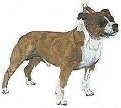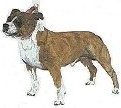
Early History
by S.L.Hemstock
(extracts from "The Stafford" 1998)

Introduction:
This page examines the origin of the Bull Breeds and in particular the Staffordshire Bull Terrier's relationship to other Bull Breeds. It examines both biology and history to produce a useful reference guide for Stafford enthusiasts. Please give feedback on the various topics covered. For example, your own theories on the origins of the Bull Breeds, and comments and suggestions on the level of detail/explanation needed in order for you to relate the mechanisms examined to your own breeding programmes, etc.. These pages will also look at the natural mechanisms which lead to the creation of various breeds (evolution) and how this process works (cell biology and genetics), and using historical evidence as a kind of "fossil record" (which should tell us which breeds/types arrived first and where) we will examine the origins and history of the Bull Breeds.
Why
is this knowledge important?
Biological concepts (such as evolution and genetics) and historical evidence for breed development may seem
separate and distinct. However, the connection between historical evidence and biological
explanation should become clearer. Please do not be put off by scientific jargon - the
principles of evolution and genetics are simple. Evolution is the first biological concept
we should examine in order to connect the history of the breed to our modern day breeding
programmes.
What can history tell us?
My motives for writing on this subject are: to dispel some of the myths surrounding the
origin of the Staffordshire Bull Terrier (particularly those relating to the height and
weight section of the breed standard); to provide readers with information on the
biological principals responsible for shaping and maintaining various breed
characteristics; and to allow the reader to ask new questions of familiar facts and ideas.
I was first prompted to write about this subject several years ago when I received a
letter from America stating that Staffordshire Bull Terriers and American Pit Bull
Terriers were the closest related Bull Breeds. However, on recently hearing a
Staffordshire Bull Terrier Championship Show judge state that Staffords are Pit Bull type
dogs - an ill-informed statement to say the least - I decided to resurrect this subject.
A passage in the letter from the book "The Staffordshire Bull Terrier in
America" (quoted below), was presented as evidence for the close relationship between
the American Pit Bull Terrier and the Staffordshire Bull Terrier.
" Although the American Staffordshire Bull Terrier was given American
Kennel Club recognition long before the Staffordshire Bull Terrier was given recognition,
the former’s ancestry can be clearly traced to dogs brought to America from Europe
prior to the Civil War..."
However, this statement confirms the hypothesis concerning the linked ancestry of
the Staffordshire Bull Terrier and the American Staffordshire Terrier and the American Pit
Bull Terrier, just as the ancestry of other Bull Breeds can be traced to similar links.
This does not, however, indicate that Staffordshire Bull Terriers and American
Staffordshire Bull Terriers are any more closely related than are, for example,
Bull Terriers and Staffordshire Bull Terriers, or any of the "breeds" known
simply as "Bulldogs" some several centuries ago. As to the absolutely true
origin of the various Bull Breeds it is, as with any other evolutionary problem, almost
impossible to procure.
Historical Evidence: 600BC to the
Middle Ages
At least two types of dog were known to exist in Britain prior to Julius Cæsar’s
invasion of 55 B.C., one of these was reported as being massive in build and the other was
smaller. The large one was employed in hunting and warfare, referred to by the Romans as
"Pugnaces", and the smaller one was used as a guard and protector, as well as
for herding. The larger dogs were highly prized by the Romans and many were sent to Rome
to provide "entertainment" in the amphitheatres. It has been reported that,
apart from size, very little separated the physical appearance of the two types of dog. In
ancient times dogs were bred for their skills and duties, for example, the gamest dogs
were picked for fighting and baiting, and little attention was paid to the physical
appearance of the animal. It is interesting to note that similarities in characteristics,
but differences in size, persisted down the centuries as in the sixteenth century small
and large "Mastiff" types were described - the large one being used for baiting
sports and the smaller type being used for guard work.
Early names used to describe "breeds" of dog in Britain include Bandog,
Band-dog, Bandogge and Tie-dog for the smaller type, and Mastyve and Mastie-dog were
generally used for the larger type. Although some of these names were not documented until
Medieval times, it is likely that they correspond to the two sorts of dog recorded in
Roman Britain.
The names Bandog, Band-dog, and Tie-dog probably owe their derivation to the fact that the
smaller dogs were bound or tied in the areas that they were guarding as both
"band" and "tie" are archaic Old Norse words for bond and restrain.
The names Mastyve, Mastie-dog and ultimately Mastiff were not, as often quoted, derived
from the word massive (meaning large, bulky or heavy) but is in fact derived from the
Latin word mansuetus, which means to make tame by handling. Evidence for this derivation
of the word Mastiff comes from the use of the words Mastyve (Mastie-dog, Mastie-dogge
etc.) prior to the use of the word massive, and that in some Tudor literature the term
Mastiff (Mastie etc.) was used to describe both small and large types of dog of similar
appearance.
The Molossos was another ancient large type of dog depicted on some Egyptian
Pharaohs’ tombs. The name Molossos was used to describe large
"Mastiff-type" dogs from Molossus, Ancient Greece.
Due to the fact that domestic animal selection was on the basis of use, rather than looks,
and that the two sizes of dog shared similar physical characteristics (other than size),
it is not unreasonable to assume that they were from a single common ancestor, and that
the large type (progenitors of the Mastiff) and the small type (largely the progenitors of
the Bulldog) are inextricably linked. It is also possible to surmise that the evolutionary
"split" of the large and small types of dogs from their common ancestor occurred
within the two centuries prior to the Roman invasion of 55 B.C. as the Romans found little
difference in physical appearance, apart from size.
Due to the presence of the Molossos and smaller dogs of similar physical appearance to the
Molossos in Egypt by 600 B.C., it is not unreasonable to assume that all these canine
types had a the same common ancestor. This common ancestor may have been imported
into Britain by the Phoenicians, the Semitic people of North West Syria who dominated
trade in the ancient world in the first millennium B.C. and founded colonies throughout
the Mediterranean.
As to the history of Bull Breeds in general, the first known
authentic record of bull-baiting took place in Stamford, Lincolnshire, in 1209. However,
by the fifteenth century the Bulldog was well documented as a "breed" as the
annals of the Knights of St. John of Jerusalem tell of the appearance of a giant serpent
on the Island of Rhodes. "Twelve Bulldogs of the true breed" were used to attack
the serpent, one of the dogs "Dreadnought" took hold of the serpent’s
throat and Deodati de Gozona, a Knight of St. John of Jerusalem, administered the lethal
blow to the serpent. The documentation presented in the annals of the Knights of St. John
of Jerusalem and the use of the term "Bulldogs of the true breed" may indicate
that some degree of contention existed over which was the "true breed" of
Bulldog and hence which points were "selected" in order to produce the
"true breed", just as there are preferred types in the Staffordshire Bull
Terrier of today.
Conclusions so far
Dog fanciers may find the history of how their favourite breed came into being
interesting, but examining the origins of the various breeds is not an just empty academic
exercise. By looking at the selection processes involved in the creation of a breed and
examining how the mechanism of these processes work we can better understand our chosen
breeding programmes.
We have examined the first concept we need to understand when looking at how species have diversified. Evolution accounts for the origin of existing species (or breeds of dog) from ancestors unlike themselves, and is achieved by a gradual change in the characteristics of a population over successive generations. The mechanism of evolution is inheritance, and the study of heredity is genetics.
Further reading
Darwin, C. (1859). On The Origin Of Species By Means Of Natural Selection Or The
Preservation Of Favoured Races In The Struggle For Life. (Edition: 1904, R & R Clarke
Ltd., Edinburgh).
Nicholas, F. W. (1987). Veterinary Genetics. Clarendon Press, Oxford.
Robinson, R. (1990). Genetics for Dog Breeders. Pergamon Press, Oxford.
Dawkins, R. (1982). The Extended Phenotype: The gene as the unit of selection. Oxford University Press.